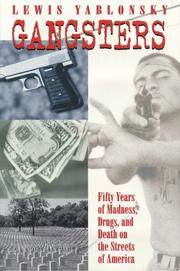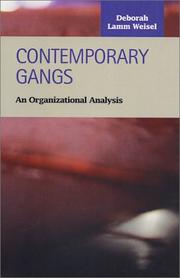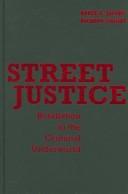| Listing 1 - 10 of 44 | << page >> |
Sort by
|

ISBN: 0814789137 0585316309 9780585316307 9780814789131 0814796796 9780814796795 9780814796887 0814796885 Year: 1997 Publisher: New York New York University Press
Abstract | Keywords | Export | Availability | Bookmark
 Loading...
Loading...Choose an application
- Reference Manager
- EndNote
- RefWorks (Direct export to RefWorks)
The effects of gang violence are witnessed every day on the streets, in the news, and on the movie screen. In all these forums, gangs of young adults are associated with drugs and violence. Yet what is it that prompts young people to participate in violent behavior? And what can be done to extract adolescents from the gangster world of crime, death, and incarceration once they have become involved? In Gangsters: 50 Years of Madness, Drugs, and Death on the Streets of America, Lewis Yablonsky provides answers to the most baffling and crucial questions regarding gangs. Using information gathered from over forty years of experience working with gang members and based on hundreds of personal interviews, many conducted in prisons and in gang neighborhoods, Yablonsky explores the pathology of the gangsters' apparent addiction to incarceration and death. Gangsters is divided into four parts, including a brief history of gangs, the characteristics of gangs, successful approaches for treating gangsters in prison and the community, and concluding with a review and analysis of notable behavioral and social scientific theories of gangs. While condemning their violent behavior in no uncertain terms, Yablonsky offers hope through his belief that, given a chance in an effective treatment program, youths trapped in violent behavior can change their lives in positive ways and, in turn, facilitate positive change in their communities and society at large.
Gangs --- Crews (Gangs) --- Crime syndicates --- Street gangs --- Teen gangs --- Teenage gangs --- Criminals --- Juvenile delinquents --- Hoodlums --- Prevention.
Book
ISBN: 1443852791 9781443852791 1299974341 9781299974340 1443850578 9781443850575 Year: 2013 Publisher: Newcastle upon Tyne, UK Cambridge Scholars Publishing
Abstract | Keywords | Export | Availability | Bookmark
 Loading...
Loading...Choose an application
- Reference Manager
- EndNote
- RefWorks (Direct export to RefWorks)
The present volume represents the first published book on gangs in the Caribbean. The study of criminal gangs is both timely and of the utmost importance to policy and security in the region. In many countries across the Caribbean, criminal gangs are increasing in number and prominence, and official crime data indicate that they are responsible for an increasing proportion of violent crimes. The Caribbean region experienced a dramatic increase in murder rates from 14.3 murders per 100,000 inhabitants in 2000 to 28.1 murders per 100,000 inhabitants in 2010. In some of the countries with compara
Gangs --- Crews (Gangs) --- Crime syndicates --- Street gangs --- Teen gangs --- Teenage gangs --- Criminals --- Juvenile delinquents --- Hoodlums

ISBN: 1280361255 9786610361250 1593320337 9781593320331 9781280361258 9781931202305 1931202303 1931202303 6610361258 Year: 2002 Publisher: New York LFB Scholarly Pub.
Abstract | Keywords | Export | Availability | Bookmark
 Loading...
Loading...Choose an application
- Reference Manager
- EndNote
- RefWorks (Direct export to RefWorks)
Gangs --- Crews (Gangs) --- Crime syndicates --- Street gangs --- Teen gangs --- Teenage gangs --- Criminals --- Juvenile delinquents --- Hoodlums
Book
ISBN: 144731719X 1306893402 1447317203 9781447317203 9781447317197 9781447317210 1447317211 9781447317173 1447317173 9781447317180 1447317181 Year: 2014 Publisher: Bristol Policy Press
Abstract | Keywords | Export | Availability | Bookmark
 Loading...
Loading...Choose an application
- Reference Manager
- EndNote
- RefWorks (Direct export to RefWorks)
Simon Harding proposes a unique theoretical perspective on survival in violent street gangs which offers new evidence on gang behaviour, dynamics, affiliation and risks in inner city areas.
Gangs. --- Crews (Gangs) --- Crime syndicates --- Street gangs --- Teen gangs --- Teenage gangs --- Criminals --- Juvenile delinquents --- Hoodlums --- Gangs --- Social aspects.
Book
ISBN: 0821416162 9780821441565 0821441566 0821416154 9780821416150 9780821416167 1869140729 9781869140724 Year: 2005 Publisher: Athens, Ohio Ohio University Press
Abstract | Keywords | Export | Availability | Bookmark
 Loading...
Loading...Choose an application
- Reference Manager
- EndNote
- RefWorks (Direct export to RefWorks)
Since the late 1940's, a violent African criminal society known as the Marashea has operated in and around South Africa's gold mining areas. With thousands of members involved in drug smuggling, extortion, and kidnapping, the Marashea was more influential in the day-to-day lives of many black South Africans under apartheid than were agents of the state. These gangs remain active in South Africa. In We Are Fighting the World: A History of the Marashea Gangs in South Africa, 1947-1999, Gary Kynoch points to the combination of coercive force and administrative weakness that characterized
Gangs --- Crews (Gangs) --- Crime syndicates --- Street gangs --- Teen gangs --- Teenage gangs --- Criminals --- Juvenile delinquents --- Hoodlums --- History --- History. --- Violence --- Violent behavior --- Social psychology
Book
ISBN: 1461443067 9786613798893 1461443075 1282056948 Year: 2012 Publisher: New York : Springer,
Abstract | Keywords | Export | Availability | Bookmark
 Loading...
Loading...Choose an application
- Reference Manager
- EndNote
- RefWorks (Direct export to RefWorks)
In contrast to the pattern of long-standing occidental street gangs modelled in the North American paradigm, new-age gangs have appeared as loosely organized, with a high degree of interchangeability of their membership. Associated with this structural fluidity is an equally significant geographic mobility, which paradoxically does not appear to diminish the intensity of personal bonds formed within and between ‘new-age’ gangs. The dimensions of fluidity of gang membership and geographic mobility across police jurisdictions is increasingly seen as the organizational pattern of emerging gangs, in large part shaped by worldwide patterns of human migration and globalization. While the structure of new-age gangs appears as loose-knit, what must be emphasized is that this characteristic is reflective of a criminal network of economic commodity-based ‘turf’ as opposed to a close-knit geographically anchored ‘turf’ that has characterized the prevailing North American (occidental) gang model. This volume illuminates the structure and organization of increasingly emergent, fluid and mobile, new-age gangs within the context of transnational networks. The implications for law enforcement agencies is two-fold: i) the fluidity of new-age gang players challenges investigative techniques that remain predicated on suspect recognition through modus operandi repetition by those involved, and; ii) the movement of new-age gang players across police jurisdictions challenges the sharing of police information. This innovative work will be of interest to researchers in Criminology and Criminal Justice, as well as related disciplines including Sociology and Anthropology studying gangs and group-organization. It has strong implications for practitioners and professionals working in law enforcement, public policy, or with at-risk youth/young adults.
Gangs. --- Crews (Gangs) --- Crime syndicates --- Street gangs --- Teen gangs --- Teenage gangs --- Criminology and Criminal Justice. --- Criminology and Criminal Justice, general. --- Criminals --- Juvenile delinquents --- Hoodlums --- Criminology. --- Crime --- Social sciences --- Study and teaching

ISBN: 9780521852784 9780511816055 9780521617987 9780511219207 0511219202 0511219881 9780511219887 9780511221170 0511221177 0511816057 0511219202 0521852781 0521617987 1107154472 1280480181 0511220308 0511314574 9781107154476 9781280480188 9780511220302 9780511314575 Year: 2006 Publisher: Cambridge New York Cambridge University Press
Abstract | Keywords | Export | Availability | Bookmark
 Loading...
Loading...Choose an application
- Reference Manager
- EndNote
- RefWorks (Direct export to RefWorks)
Street criminals live in a dangerous world, but they cannot realistically rely on the criminal justice system to protect them from predation by fellow lawbreakers; they are on their own when it comes to dealing with crimes perpetrated against them and often use retaliation as a mechanism for deterring and responding to victimization. Although retaliation lies at the heart of much of the violence that plagues many inner-city neighborhoods across the United States, it has received scant attention from criminologists. As a result, the structure, process, and forms of retaliation in the real world setting of urban America remain poorly understood. Street Justice: Retaliation in the Criminal World, first published in 2006, explores the face of modern day retaliation from the perspective of currently active criminals who have experienced it first hand, as offenders, victims, or both.
Gangs --- Revenge --- Vendetta --- Blood feuds --- Feuds --- Self-help (Law) --- Lex talionis --- Truce of God --- Vengeance --- Retribution --- Crews (Gangs) --- Crime syndicates --- Street gangs --- Teen gangs --- Teenage gangs --- Criminals --- Juvenile delinquents --- Hoodlums --- Revenge. --- Social Sciences --- Sociology
Book
ISBN: 1282422596 9786612422591 0472021982 9780472021987 0472116290 9780472116294 9781282422599 6612422599 9780472034680 0472034685 Year: 2009 Publisher: Ann Arbor
Abstract | Keywords | Export | Availability | Bookmark
 Loading...
Loading...Choose an application
- Reference Manager
- EndNote
- RefWorks (Direct export to RefWorks)
An alarming report on Latino crime gangs and the efforts of U.S. law enforcement to contain them.
Hispanic American gangs --- Gangs --- Gang prevention --- Gang intervention --- Intervention, Gang --- Prevention of gangs --- Crime prevention --- Crews (Gangs) --- Crime syndicates --- Street gangs --- Teen gangs --- Teenage gangs --- Criminals --- Juvenile delinquents --- Hoodlums --- Gangs, Hispanic American --- Prevention
Book
ISBN: 1283901706 0252094484 9780252094484 9781283901703 9780252037306 0252037308 9780252078781 0252078780 Year: 2013 Publisher: Urbana University of Illinois Press
Abstract | Keywords | Export | Availability | Bookmark
 Loading...
Loading...Choose an application
- Reference Manager
- EndNote
- RefWorks (Direct export to RefWorks)
This book provides a comprehensive sociological explanation for the emergence and continuation of organized crime in Chicago. Tracing the roots of political corruption that afforded protection to gambling, prostitution, and other vice activity in Chicago and other large American cities, Robert M. Lombardo challenges the dominant belief that organized crime in America descended directly from the Sicilian Mafia. According to this widespread "alien conspiracy" theory, organized crime evolved in a linear fashion beginning with the Mafia in Sicily, emerging in the form of the Black Hand in America's immigrant colonies, and culminating in the development of the Cosa Nostra in America's urban centers. Looking beyond this Mafia paradigm, this volume argues that the development of organized crime in Chicago and other large American cities was rooted in the social structure of American society. Specifically, Lombardo ties organized crime to the emergence of machine politics in America's urban centers. From nineteenth-century vice syndicates to the modern-day Outfit, Chicago's criminal underworld could not have existed without the blessing of those who controlled municipal, country, and state government. These practices were not imported from Sicily, Lombardo contends, but were bred in the socially disorganized slums of America where elected officials routinely franchised vice and crime in exchange for money and votes. This book also traces the history of the African American community's participation in traditional organized crime in Chicago and offers new perspectives on the organizational structure of the Chicago Outfit, the traditional organized crime group in Chicago.
Gangs --- Criminals --- Organized crime --- Crews (Gangs) --- Crime syndicates --- Street gangs --- Teen gangs --- Teenage gangs --- Juvenile delinquents --- Hoodlums --- Crime and criminals --- Delinquents --- Offenders --- Persons --- Crime --- Criminal justice, Administration of --- Criminology --- Organised crime

ISBN: 1593321899 9781593321895 9781593320980 1593320981 Year: 2005 Publisher: New York LFB Scholarly Pub.
Abstract | Keywords | Export | Availability | Bookmark
 Loading...
Loading...Choose an application
- Reference Manager
- EndNote
- RefWorks (Direct export to RefWorks)
Gangs --- Violence in adolescence --- Violent crimes --- Crimes, Violent --- Crimes of violence --- Crime --- Violence --- Adolescent psychopathology --- Crews (Gangs) --- Crime syndicates --- Street gangs --- Teen gangs --- Teenage gangs --- Criminals --- Juvenile delinquents --- Hoodlums --- Chicago Metropolitan Area (Ill.) --- Social conditions.
| Listing 1 - 10 of 44 | << page >> |
Sort by
|

 Search
Search Feedback
Feedback About UniCat
About UniCat  Help
Help News
News